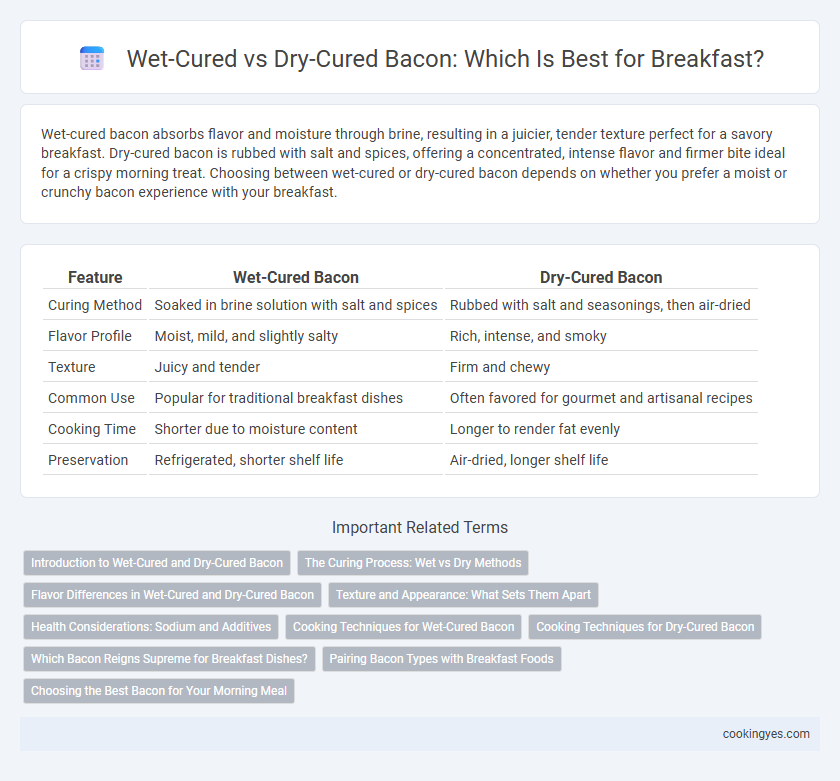Wet-cured bacon absorbs flavor and moisture through brine, resulting in a juicier, tender texture perfect for a savory breakfast. Dry-cured bacon is rubbed with salt and spices, offering a concentrated, intense flavor and firmer bite ideal for a crispy morning treat. Choosing between wet-cured or dry-cured bacon depends on whether you prefer a moist or crunchy bacon experience with your breakfast.
Table of Comparison
| Feature | Wet-Cured Bacon | Dry-Cured Bacon |
|---|---|---|
| Curing Method | Soaked in brine solution with salt and spices | Rubbed with salt and seasonings, then air-dried |
| Flavor Profile | Moist, mild, and slightly salty | Rich, intense, and smoky |
| Texture | Juicy and tender | Firm and chewy |
| Common Use | Popular for traditional breakfast dishes | Often favored for gourmet and artisanal recipes |
| Cooking Time | Shorter due to moisture content | Longer to render fat evenly |
| Preservation | Refrigerated, shorter shelf life | Air-dried, longer shelf life |
Introduction to Wet-Cured and Dry-Cured Bacon
Wet-cured bacon is processed by immersing pork belly in a brine solution containing water, salt, sugar, and curing agents, resulting in a moist and tender texture ideal for breakfast dishes. Dry-cured bacon involves rubbing the pork belly with a mixture of salt, sugar, and spices, then air-drying for several days, creating a firmer texture and more concentrated flavor. Both curing methods influence the bacon's taste profile, moisture content, and overall breakfast experience.
The Curing Process: Wet vs Dry Methods
Wet-cured bacon is soaked in a brine solution containing salt, sugar, and nitrates, allowing for a quicker absorption of flavors and moisture retention, resulting in a tender texture. Dry-cured bacon undergoes a coating of dry salt and curing agents, drawing out moisture and intensifying flavors through a slower, traditional process that produces a firmer, more concentrated taste. The choice between wet and dry curing significantly impacts the bacon's flavor profile, texture, and shelf life, influencing breakfast preparation and preference.
Flavor Differences in Wet-Cured and Dry-Cured Bacon
Wet-cured bacon, soaked in a brine solution, typically delivers a milder, saltier flavor with a slightly moist texture, enhancing its savory profile for breakfast dishes. Dry-cured bacon, rubbed with a mixture of salt and spices and aged longer, offers a more intense, robust, and concentrated flavor with a firmer, chewier bite. The choice between wet-cured and dry-cured bacon significantly impacts the overall taste experience, with dry-cured varieties favored for their deep, smoky complexity and wet-cured options prized for their balanced, tender consistency.
Texture and Appearance: What Sets Them Apart
Wet-cured bacon absorbs a briny solution, resulting in a moist, tender texture and a glossy, pinkish appearance. Dry-cured bacon is coated with salt and spices, producing a firmer, chewier bite and a darker, more rustic color with visible seasoning. These curing methods distinctly influence breakfast presentation and mouthfeel, catering to different taste preferences.
Health Considerations: Sodium and Additives
Wet-cured bacon contains higher sodium levels and often includes additives like phosphates and preservatives, which may impact blood pressure and overall heart health. Dry-cured bacon typically has a more natural curing process with fewer additives but can still be high in sodium, requiring mindful consumption. Choosing lower-sodium options and monitoring portion sizes helps reduce health risks associated with both types.
Cooking Techniques for Wet-Cured Bacon
Wet-cured bacon involves soaking pork belly in a saltwater brine infused with sugar, nitrates, and spices, which enhances moisture retention and imparts a mild, balanced flavor. This method requires precise temperature control during curing and typically a shorter curing time compared to dry-cured bacon, resulting in tender slices ideal for frying or pan-searing at medium heat to achieve optimal crispiness without drying out. Cooking wet-cured bacon demands careful attention to prevent excessive grease splatter and ensures even browning, making it a preferred technique for hearty breakfast dishes.
Cooking Techniques for Dry-Cured Bacon
Dry-cured bacon involves coating pork belly with a mixture of salt, sugar, and spices, then allowing it to cure for several weeks to develop intense flavor and firm texture. Cooking techniques for dry-cured bacon typically include slow pan-frying over low heat or baking in the oven at a moderate temperature to render fat evenly and achieve crispness without burning. This method preserves the rich, smoky profile and chewy bite characteristic of artisanal dry-cured bacon, making it an ideal choice for gourmet breakfast dishes.
Which Bacon Reigns Supreme for Breakfast Dishes?
Wet-cured bacon, soaked in a brine solution, offers a juicier and more tender texture, ideal for moist breakfast dishes like eggs and pancakes. Dry-cured bacon, coated with salt and spices, delivers a more intense, smoky flavor and crispier bite, perfect for enhancing savory morning meals such as omelets and breakfast sandwiches. For breakfast, dry-cured bacon often reigns supreme due to its bold taste and satisfying crunch that complements a wide variety of dishes.
Pairing Bacon Types with Breakfast Foods
Wet-cured bacon, known for its tender texture and mildly salty flavor, pairs exceptionally well with soft scrambled eggs and buttery pancakes, enhancing the breakfast's overall creaminess. Dry-cured bacon offers a more intense, smoky profile that complements robust dishes like omelets with sharp cheeses or hearty vegetable hashes. Choosing between wet-cured and dry-cured bacon can elevate breakfast by matching the bacon's curing method with complementary textures and flavor profiles in the meal.
Choosing the Best Bacon for Your Morning Meal
Wet-cured bacon is soaked in a brine solution, resulting in a juicier and more tender texture, ideal for those who prefer a salty, moist bite with their breakfast. Dry-cured bacon, rubbed with a salt and sugar mixture, offers a firmer texture and concentrated flavor, perfect for a crispier, more intense morning meal experience. Selecting between wet-cured and dry-cured bacon depends on your taste preference for either a savory, moist slice or a robust, drier flavor to complement eggs, toast, and coffee.
Wet-cured vs Dry-cured bacon for breakfast Infographic

 cookingyes.com
cookingyes.com